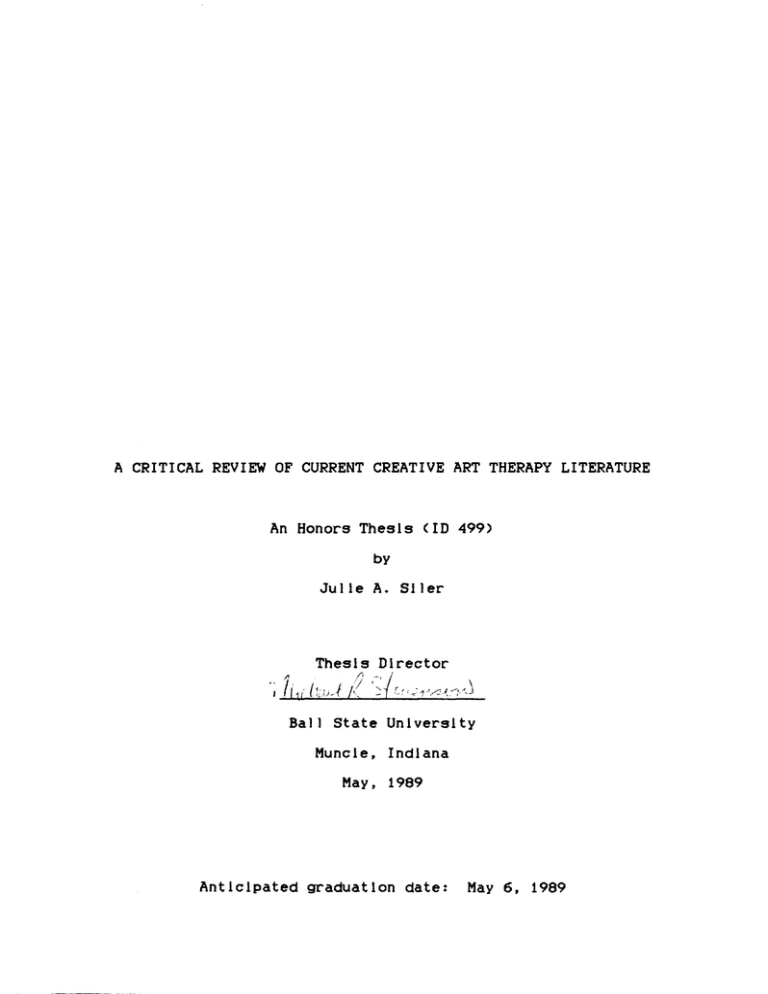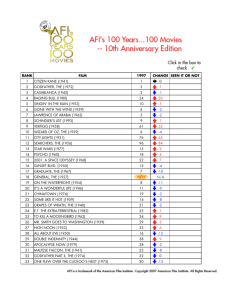A CRITICAL REVIEW OF CURRENT CREATIVE ...
advertisement

A CRITICAL REVIEW OF CURRENT CREATIVE ART THERAPY LITERATURE An Hono~s ThesIs (ID 499) by Ju lIe A. S 11 e[" Ball State Unlve~slty Munc Ie, I ndl ana May, 1989 Anticipated g~aduatlon date: May 6, 1989 Art therapy Is a human servIce professIon utIlIzed In personal It'v assessment, treatment, rehabIlItatIon, and educatIon. It "Is a dIscIplIne wIthin the mental health fIeld that uses visual arts as a tool In psychological counseling (Meheran, 1987)." An art therapist must have the knowledge IJf visual symbol productIon, skIlls In crisis intervention, understanding of normal and abnormal behavior, and experIence wIth creatIve expressions In art in order to develop di.~gnostic assessments and treatment plans. These plans for treatment are Incorporated Into a total therapy program developed by a variety of professionals such as psychologists, counselors, and medical doctors. Art therapy orIgInated In the 1930/s and has grown slowly, but steadIly. Great Britc~in DurIng the 1940/s, Adrian Hill In and Margaret Naumburg in the United States were responsIble for the transItIon of art therapy from a theory to c~ profession. The educational programs and requirements have grown from two master programs in 1970 to seventeen ciccredited programs and over 80 other schools that offer classes or programs; the American Art Therapy AssocIatIon (AATA) that was founded In 1969, recorded 433 active members in 1976 (Ulman, 1976) and expanding to just under 3000 active members In 1988 (AATA). ,~~( 558i 2 Despite the unification and have not the~apists A the~apy. Is p~oblem a~ts," "the to p~actical scheme "c~eative a~t "exp~essive a~ts" fo~ a~t to music, theat~e the~apy" These d~awing, At times this distInctIon is confusing. The te~ms "exp~essIv.! a~t the~apy" to bette~ solutIon the f()~ gene~al delineate the unsu~e and studies about app~oaches va~y. of o~ othe~ a~t times It Is pape~ and to In offe~ a lite~atu~e. If conflicting will cove~ a~t ~esea~ch the~apy." c~eative a~t ART PSYCHOTHERAPY. in which pal~ed to dance wo~kIng lInked wIth the~apy. Two maIn subdivIsions communIcatIon of and this fo~ hea~s pape~ va~lety and sculpting. the~apy" dIffe~ences This "c~eative WIthIn the fIeld of nonve~bal and at c~eated Is the~apy p~ofesslons wIll be affected. accepted: a~t "fIne o~ f~om poet~y the ambiguitIes in the exIsting public is a~t a~t to using a ~ange clea~, we~e a~ts" photog~aphy, "c~eative definItIons, then those In the~apy "exp~essive ~efe~s whe~eas c~eative solely with painting, o~de~ and about "the the~apy" exp~ession. p~ecise dealing with thIs definitIon fo~ hea~s a~t of actIvItIes utIlIzed In spect~um Just as one the~apy." consensus on a ~eached defInItion due to the in this field, g~owth wIth the a~e a~t the~apists/ ~eadlly Is a means of psychothe~apeutic 3 process of associations and interpretatIons used to understand and work through emotional problems; and ART AS THERAPY, whIch uses the art experIence and the process of creating ar.t to reconcile contradicting beliefs within the patient and between the patient and society. The artwork is deemed special for its psychological value of being created (Ulman. 1976). These two InterpretatIons were derived from different predecessor.s (Simon, 1975). The first was a psychological viewpoint of the value of art and the latter was (more or less) the artists' brainchIld. Both approaches are concerned '4ith communication and dealing with one's problems, but art as therapy focusses on the prIvate internal pr.ocesses the client experIences during therapy. Whereas art psychotherapy emphasizes interpretatIon and interaction throughout the session (Simon. 1975). The two vIewpoints are responsible for the difficulties of defining art therapy, although today most creative art therapists in both schools accept each other's professions. Compromises and allowances have been made, although how it is defined determines who will benefit from creatIve art therapy along with the t~,pes of procedures to be used and the kind of results to be expected. 4 Creat.lve art therapy has been applied to a number of patIent populatIons IncludIng blind, autistIc, schizophrenIc, abused, drug-addicted, and abandoned I ndi v i dua l~' of many ages, races, re Ii gi ous sects, geographiccil areas, and socIoeconomIc levels (Dennis, 1966; Alland, 1983; DI Leo, 1983). Generally, creatIve art therapy is universal, but that probably stems from the fact that art Is unIversal. Humans have been drawIng and creating ar.tworks since before written history--otherwise, anthropologists and archeologists would have very little informatIon to determine the lifestyles of lost cultures. The images and creative useful items found by acheologists help to communicate the lifestyle to us today, just as art today helps people communicate ideas and emotions. Because many different groups have been introduced to creative ar.t therapy, a very wide varIety of media has been required. From computer art to pencils, paints, and clay, many combinations are possible to form with the materials. These materials are carefully chosen and experimented wIth In order to prevent problems that specifIc populatIons may encounter \Iith certaIn media. For instance, elderly populations and persons wIth muscular disorders such as cerebral pellsy have a dIffIcult tIme manipulating clay due 5 to lack of muscle strength and coordInatIon, and other medIa ought to be explored. The maIn problem wIth the fIeld of art therapy Is that there Is very lIttle objective evIdence that clearly supports the effectIveness of art therapy. ThIs leads to a lack of confIdence of It as a successful therapy. The scarcIty of empirical literature is partly due to the problems dIscussed previously concerning the vague defInItIon of art therapy, how it is to be done, and what type of results can be achieved when It is used. By not pursuing valId studIes to Illustrate art therapy/s success, the general population and persons In related fIelds wIll never respect art therapy as an occupation, or as a reliable form of treatment (Gibson, 1975: McNiff, 1986). It already has gained the respect and confidence of the people who work wIth It (GIbson, 1975); piles of case studies have shown personal success in isolated cases. The strength of valid empirIcal I:-esearch that utIlizes control groups and objective methods Is vital to the future of art therapy. The survIval of art therapy as a method of dIagnosiS and treatment I:-elies on the acceptance of It by others (Simon, 1975: GIbson, 1975: Oster & Gould, 1987). And to be accepted, we must present strong evIdence of Its worth. As 6 a means toward thIs end, thIs manuscrIpt revIews the current empIrical lIterature. In order for creative art therapy to become an establIshed method of treatment, it must gaIn recognition and support of other allied health and human servIce professionals (GIbson, 1975; Oster & Gould, 1987; AATA, 1988). This needs to be approached first by producing valid research, clnd second by publIcIzing what creatIve art therapy is and how it works. art therap~, This strategy allows creative a supportIve base from whIch It Is able to expand (McNiff, 1986). Research In the scIences and humanItIes has followed a consIstent path of gradually adopting more qualified and quantIfIed studies. If creatIve art therapy is to flourish, the research techniques need to challenge other professIonals and illustrate where and how this mode of treatment Is effective. Originally, creative art therapIsts wrote and published case studies. interestin~~; bIas of thE~ This method can be informative and however, case studies are vulnerable to extreme therapist along with the relatively uncontrolled environments where the therapy occurs. Findings of case studies also do not generalize satisfactorily to other clIents wIth eimilar problems. conclusion~J Therefore, erroneous may be drawn concerning the applicatIon of 7 clInIcal case studIes, a legItImate problem carried over from psych,oana I ysl s, one of the therapy. II parent theor 1es" of art One effectIve way of utIlIzIng case studIes Is to survey a gic"OUp of sImIlar cases In order to "create generalIzatIons about groups of IndIvIduals (YIn & Herald, 1975 as cIted by LIght & PI I lemer, 1984)." CreatIve art therapy needs to provIde data that Is recent and valId. This is a diffIcult task because art never has lent itself to classifications and boundarIes (McNIff, 1987). The problem stems from the fact that art is a projective test. Even In a completIon art test when guidelines to the task are clear, a cllent/s interpretatIon of what Is there and how he/she should fInIsh It, depends on hIs/her past experIence and current emotIons. It Is not delIneated lIke a multIple choIce MMPI, but rather the range of responses is large whIch produces results that are specIfIc to each IndIvIdual person. The clIent creates a pIece of ar.twork from a varIety of supplIes combined with an Inner motIvatIon or Idea. Thus even a Rorschach test or TAT 1s more stcindardl zed than the art produced dur 1ng creat I ve art therapy. One way to deal wIth these problems Is to assess a client/s adjustments before and after therapy by usIng a battery of personalIty and psychologIcal assessments. ThIs 8 would illustrate dIfferences In the clIent that are assumed to be related to the therapy encountered between testings. The scores produced would allow other professionals to understand and easily see the results of the therapy. Another solutIon Is to develop new methods of research that are devised for the creative art therapy situation (Rubin, 1984: Dalley, Case, Schaverien, Weir, Halliday, Hall, and Waller, 1987: McNiff, 1986; Rosal,1988). One of the major research pr.oblems Is that for tIght empIrically-based laboratory experiments to show creative art therapy is effectIve, we must Infringe upon the clInical environment. Unusual charaterlstlcs In the artwork of people who are experi.~ncing sImilar problematic situations have been investIgated in order to produce diagnostic criterIa for partIcular patient populatIons (Wester, 1967; Rowe, 1974: Wadeson, 1980; Bergland, 1982; Koppitz, 1984; Rubin, 1984). For exampl~~, in several studies comparisons were made of typical artwork for a specific type of client, and were recorded along with the individual/s progress rates (Zierer, 1976: Silver & Lavin, 1977; Horovitz, 1983). Other avenues whIch provide logical support for creative art therapy use are: outcome evaluation studies, normative studIes, and descrIptIve studIes (Wadeson & Carpenter, 1976). These are all possIble alternatIves to 9 strictly c()ntrolled experimental situatIons. Some have argued that: the reason behInd avoIdIng controlled research Is that creative art therapy Is a human servIce profession that places people and theIr problems fIrst. They consIder the stress of an experImental sItuation harmful to an already troubled IndivIdual. From thIs posItion. ethIcal concerns for the clients put strict research efforts on hold. but \Ihile we wait. the publIc and other professionals become mor~~ skeptIcal of art therapy/s effectiveness. Also, as mentioned above, It Is highly possible that creatIve art therapy ne~~ds to develop its own new and orIginal methods of research and assessment of the therapy/s success (Wadeson. Gantt. Junge. & Lusebrlnk, 1988). CreatIve art therapy may be too dIverse and far-removed from behavIoral psychology to use the same focus and methodology. although thIs does not Imply that cooperative research between creatIve art therapy and other dIscIplInes is impossible or Invalid. DiagnostIc uses of CreatIve Art Therapy Another use of creative art therapy is in the dIagnostIc area of psychologIcal and personalIty assessment. Many drawIng tests (DAP. DAT) have been developed for the sole purpo~~e 1987). of clInical assessments (Oster and Gould, These tests range from completing a fIgure to drawIng a dIrected Image. McCarter (1970) completed a 10 doctoral thesis that examined a drawing-completIon test. He provIded background materIal. procedures. and statIstIcal measures. A complete assessment guide written by Oster and Gould (198'7) clearly Illustrated how to use and wIth whom to use a bat t.~ry of drawl ng tests. They are v I ta I for IllIterate people and for chIldren whose InsufficIent knowl edge .:lnd expert I se of the 1anguage lIml t the effectiven.~ss of other methods (Goodnow. 1977). They do not have to spt!ak clear I yIn order to commun I cate how they fee 1 (Levick. 1986. Golomb. 1974. Silver. 1978). Comparisons have been rna de between dIagnoses gIven by creative art therapIsts or related professionals from a serIes of drawIngs and those done by professionals who utIlIzed more "tradltloncil" and "empirIcal" methods (GIbson. 1975; Wadeson & Carpenter'. 1976; SlIver, 1978), The studIes show that a creatIve art therapIst can dIagnose relIably usIng hIs/her methods. In realIty. thIs is an area In whIch many creatIve art therapIsts have flourIshed and gaIned respect. A COMMENTAI~Y. SURVEY, AND EVALUATION OF CREATIVE ART THERAPY METHODS A variety of opInIons have been voIced about creatIve art therapy and the role It plays in evaluatIng and counselIng people. SImon (1975) suggested that the 11 dIchotomy of the fIeld Is too delIneated and that compet 1t 1v~me!Ss constant 1y ex i sts between "art as therapy" and II art p!,ychotherapy." holistic tl~aIning She emphasl zed the Importance of a in which a therapIst would use whatever is approprIate for the client. This would provIde an IndividualIzed treatment program for each person, somethIng she consid~~red a necessity. The two approaches, to her, represent an expansIon of methods of treatment, not lImiting dogma tIc f ()rces . Gibson (1975). on the other hand. surveyed mental health clinicIans. actIvIty therapists. and creatIve art therapists in order to arrIve at some conclusIons about the wide-spread attitude of creatIve art therapy. She proposed three hypotheses concerning the relationships between those occupatIons analyzed: 1) all profeSSions should agree on an optimum mode of treatment for a specifIc disorder. 2) creative art therapy should be ranked above all forms of actIvIty therapy due to its sImilarIties to IndivIdual and group therapIes. 3) clinical skills are held in hIgher esteem. an(j since activity therapy is further removed from clinIcal than the other methods. it wIll receive more lower ratIngs. The results showed that creative art therapy was not as fav()red or well-known as expected by the experiment~~r. She concludes that art therapists are more 12 confIdent and enthusIastIc about theIr work than the rest of the profesl3ionals. This suggests that educatIon of the cormlunity ,:lnd cooperatIon. not competition. with other mental health professionals should be our goals. Another study (Zamierowski. 1980) expressed the usefulness of creative art therapy because it allows the brain to pr.oduce alpha waves and to connect the hemispheres together. She stated that thIs Induction of alpha waves can enable a learning dIsabled child. who typically can control only one side, to successfully combine thoughts and actions of both par.ts. CreatIve art therapy is characterIzed by certain inherent qualities that separate it from other dIscIplines. She lists emotional. cognitive, and perceptual benefIts te) children with learning disabilities who participat.~ in creative art therapy. Zamierowski (1980) notes that art therapy Is an indIvIdualized holistIc treatment because each case can be clIent-directed and since the right hemisphere Is stimulated, the left one can be "Jump-started." Creativity is more integratIve and effectIve than cognitIve or behavioral methods. And thus the person treated wIth art therapy gaIns in all areas instead of improving in Just the area chosen by a different type of therapIst. 13 CreatIve art therapy Is not always evaluated positively., In a revIew of European lIterature, Gamna and Bortino (1980), dId not support the methods of therapy, the presentation of data, or the Journals that publIshed the studIes. shown to wider They stated that creatIve art therapy has not been bt:~ effect 1ve and it shou I d be absorbed I nto the framt:~work tool. of occupational therapy as a diagnostic To them, creative art therapy is too restrictIve and people are handled In a depersonalized manner. The active particlpatllon of the members In this fIeld, according to Gamna and Bortino (1980), is dwIndling. They contacted about 5.000 professIonals who were supposedly usIng creatIve art therap~' throughout Europe, AsIa, North and South America. and Africa to survey about the use of creatIve art therapy: the setting. type of patients, duration of its use there ... ThAs short questionaire was returned by only 300 respondent!, and about ha I f of those were from I ta I y and France. The author suggested. however. that creative art therapy should expand into areas of marIonettes and cinema. They believe that animation provIdes a more realIstic mode of expression, and thus it would prove to be a more helpful means of communication. REVIEW OF RESEARCH LITERATURE 14 CASE STUD I :E:S Overa)), the case study method domInates the creatIve art therap:v 11 terature, a I though other more object 1ve techniques are becoming more common. Case studIes have lImIted value In the research world, but they do contrIbute informative and descriptIve accounts of situations in which creatIve aJ:-t therapy Is appl icable (LIght & PI 1 lerner, 1984). But, because a case study covers an isolated example of one therapeutic situation applied to an indivIdual personalIty, the relevance of how one method pertaIns to another study is uncertain. The conclusions drawn from a series of case studIes may not be valId since the conditions probably varIed grecitly. Also, how a therapIst presents the materIal is vItal t() the amount of research value a study contains. For exampl~~, a case study that has followed a specIfIc type of prelimInary evaluatIon or therapy cormnands more attentIon In the fIeld of research than a purely story-lIke descr Ipt 1VE~ techn 1que. A samp 11 ng of severa 1 case studi es that fo 1 10\01 the more research-or 1ented procedure were revIewed (ZIerer, 1975, Zierer, 1976; Bergland, 1982; HorovItz, 1983). Zierer (1976) admInIstered the same fIve steps of her evaluatIon to all the clIents, and she also presented emp i rica I E!V idence that supported her method of therapy. 15 The case studIes she Introduced Illustrate the practIcal applications/Implications of the theoretIcal and empIrical evidence that she previously examined (Zierer, 1973 as cIted by Zierer, 1976; Zierer, 1975 as cited by Zierer, 1976). Bergland (1.982) addressed her geriatric pilot study In a very s I mI I clr manner. prevIous rE~search She qua I 1£ i ed her study by comb I n I ng that examIned: the life revIew process (Butler, 1963 as cIted by Bergland, 1982); the conflict between ego integrity and ego despair (Erikson. 1959 as cited by BE~rgland, 1982); the Intergenerational sharing of cultural experIences and values (Kuhn, 1977 as cIted by Bergland, 1982); several creative art therapIsts experIences wIth gerIatrIc patIents (Dewdney. 1973 as cIted by Bergland, 1982; ZIeger, 1976 as cIted by Bergland, 1982; Jungels, 1979 as cIted by Bergland, 1982). She presented a useful format in order to examine the gerIatrIc populatIon that consi~:rted of two populations at separate instItutIons. The first ()f these groups contaIned women at a long-term state facilli ty, and the second encompassed men and women at a short-term private hospital. The particIpants were introduced to creative art therapy and produced a lIfeline complete wlth personal memories along wIth a drawing of theIr choIce. Then, In the following sixteen weeks for the first group, and eleven weeks for the second group, the 16 subjects produced art In a structured developmental order of topIcs. At the end of the study, the lIfelIne and free drawing exercise was repeated. completed I~n StatIstIcal evaluations were the differences between the two lIfelines and free drawings by independent raters who Illustrated a significant level of consistency. The persons at the short-term home improved the organizatIon of theIr artwork much more than those at the long-term facIlity. subJects~ were Fourteen data was presented in a chart format, all of these contrl~l led for age, sex, and dIagnosIs. Then, Bergland (1982) employed the empIrical data in a representatIve case study. This Illustrated how the creatIve art therapy experience affected one person out of these groups In order for the reader to grasp the type of changes that occurred. A different type of emphasis found In case study research involves recording consIstent longitudinal data. This tedious process allows the closely monItored. Individual~s progress to be A developmental approach may be able to detect the turning poInts durIng the therapy, like those shown In the serIes of case studies by HorovItz (1983) and Powers and Langworthy (1978). Horovitz (1983) worked wIth chIldren In a therapeutIc nursery school and thIs progress report method enlightened other professIonals who cared for the chIldren about their level of functIonIng and stabIlity, 17 both of whl.ch are vItal InformatIon when the chlldren/s welfare Is concerned. The bases for her technIque of treating the chIldren were well-documented throughout her study. PO\ierS and Langworthy (1978) presented goals of the therapy trEtatment program prior to their case studIes. also utili~~ed They a developmental approach of recording behavioral changes In order to determIne If the goals were beIng achieved. These methods are less reliable than the standardizEtd admInIstration procedures that were prevIously explained, but it is better than the simplistic, over-generalized case reports that at one tIme were the rule, not the exception, in the field of art therapy. STUDIES THAT APPLY EMPIRICALLY-BASED METHODS One group of studIes utIlIzes empIrIcal methods, except that varIables are not accounted for as In a true experiment(~1 research study. tE~chniques, These studies attempt to follow strict such as pre- and/or post-testIng, but they also present limIted control because of the numerous envIronmental varIables durIng the therapeutIc tIme between testings. The common characteristIc between these applIcable studIes Is preliminary assessments of the subject pool (Rowe,. 1974; Silver, 1975; Wadeson & Carpenter, 1976; Silver & Lavin, 1977; KwIatkowska, 1978; Levy, 1978; 18 1982; Be~gland. Sandbu~g, Silve~, & Vilst~up, 1984). diagnostic technique is helpful because In the usefulness of demonst~at.! c~eative o~de~ a~t This to the~apy one needs to have an estImation of the client's ability to function. The methods of establishing these levels of functioning a~e but the va~Ied. They a~e impo~tant Is that they exist. facto~ a vItal component to valid ~esea~ch. Rowe (1974) wo~ked with adults of intellect below the mental age of two yea~s. and she had to theI~ skII]s assessed behavIo~s we~e These developmental FIve Items that app~op~lately. with imItation t~eatment. a system that would evaluate c~eate we~e befo~e chosen acco~dIng that Illust~ated ~esea~ch dI~ectly and dealt afte~ to Plaget's connectIons between a child's physical and cognitive development. Anothe~ example of modIfying the evaluation inst~ument to the type of patient population is the pIlot study of two ge~Iat~Ic \Ia~ds p~oJect by that used a topiCS to (:onst~uct Be~gland se~Ies a She chose a tIme lIne (1982). of c~eative ch~onologlcally-o~ganized fo~mat fo~ olde~ Levy (1978) examined women in the Kentucky InstItutIon and Initially o~de~ to or'ient he~self p~ovlded to the an open adults. Co~~ectlonal envl~onment pe~sonal1ties In the in p~og~am. 19 In de4!llng with the treatment of familles, Kwiatkowska (1978) utilized sIx procedures of evaluating troubled families: Individual free pictures, a family portrait,an abstract f'!mily portrait, an individual scribble, the Joint family scribble, and another free picture. drawings pl~oduced problems. This sequence of a valid method of assessIng the family~s It also may be adapted to all types of family systems. SlIver and Lavin (1977) selected learning-Impaired chIldren wIth varying degrees of hearing loss and tested theIr VIsual, spatial, and motor abilities. More specifically, these tests drew upon their abilities to form groups fran illustrations of loosely related objects. The chIldren also had to draw an arrangement of objects in order to indicate their perceptions of spatial relationships. The third task encouraged spontaneity and exploratory learning by allowin~~ the children to experiment with clay and paInt mixIng. Several of the studies utilIzed prepared and standardIzed stImuli. A useful system of picture stimulI was developed by Silver (1975) In order to evaluate the skIlls of clnd follow the developments of chIldren with communication disorders. ThIs standardIzed technique generated new teachIng methods for children wIth language 20 and hearing impairments. objectIvely document the It also provIded a means to children~s progress because the same cards were shown durIng different therapy sessions. SlIver (1975) also formed a system of evaluating the children~s level of cognitive and artIstic development by ratIng the images drawn by the chIldren on three criteria: the abIlIty to select elements with meaningful connections, the ability to combine the elements, and the abIlIty to represent those objects. Therefore, thIs technique not only allows the populatIon to be pre-tested, but It also shows the progress achIeved throughout the therapy session between the testlngs. Severiil other studIes applied this method to somewhat different subject populatIons, but with similar communicatIon difficultIes (SlIver & Lavin, 1977; Sandburg, Silver, & Vilstrup, 1984). Because of the particular strengths previously mentioned concerning this method, these later studies provIde valid data to Illustrate the effectIven~~ss of creative art therapy. The therapeutic process can be well-documented due to the fact that the data is gathered longitudInally throughout the treatment program. The post-therapy evaluatIon Is found In the majorIty of the lIterature. patlent~s Some type of summary concernIng the current condItIon or level of functIonIng 21 generally l.s included, although several studIes illustrated excellent technIques to determine the effectivenE~ss treatment~s (Rowe, 1974; Silver, 1975; Silver & Lavin, 1977; Kwiatkowska, 1978; Sandburg, SlIver, Viistrup, 1984). Overall, lIterature that describes practIcal applications of creative art therapy is acceptable conslderin~~ the unexpected sltuations and problems of a clinIcal environment. were The scarce number of studies that In those conditions were well-handled, and complE~ted utIlized standardized stimuli or procedure in order to present an applicable and valid study. The evaluations before and after therapy are vital to the strength of the data, and <lny Information provided durIng the treatment Is beneficIal to the studies. STUDIES THAT PRESENT NEW METHODS FOR EMPIRICAL RESEARCH Several researchers have devised unique and practIcal technIques especially for empirical studies of the effects of art thel~apy. They engineered delicate balances of a therapeutic use of art in a stable experimental design. The method utilized by Silver (1975) to determine the cognitive and artistllc development of children with communication disorders ~/as ingenious. She manufactured cards with line sketches on them and proceeded to have the children pick out 22 a few. Them the ch 11 dren were supposed to create a coherent story from the cards. They were Judged on the ability to select, to combine, and to represent the elements from the various cards. She assigned point values to the children's drawIngs, cmd compared them wI th the post-test scores. The differences between pre- and post-test scores help to establIsh that the creative art therapy utilized In between testlngs was helping the children. new This method opened many for data gathering in the art therapy situation. option~~ Ziegler (1976) presented an illustration of the dependable diagnoses that the Wlnnicott's squiggle game provides. He believes It Is Important for the therapist to be an active participant in the game. This allows direct contact and spontaneous reaction from the patient. The level of the child's muscular coordination and verbal abIlities are well-assessed, besides the problems that are troubling him or her. He states that what the patient does n2i draw at:-e very Important to the evaluation. (1976) did note the limitations of the game. work very \t1e Ziegler It does not I I with per f ec t Ion I st ch I I dren because they wI I I not allow the pencil to create a flowing line, but rather force a gec>metric designs into the game. These are difficult to make a picture from, and casual scribbles did not keep their Interest in the game. 23 Conclusion My per.sonal definition of what creative art therapy Is and who it helps and/or can help is as follows: I believe crea t I ve al:-t therapy 1s successfu lIn demo I 1sh i ng a language barrier. Persons with communication disorders such as autism, muteness, stroke after-effects, seem to be greatly helped. Ar.tistlc expression is the link to their Inadequate or lost symbolic functIonIng. ThIs means that any ImpaIrment In one/s communIcatIon system, whether It be total or partIal, can be less of a burden by the creatIon of new channels and outlets for the patient. Throughout this comprehensive revIew of creatIve art therapy lIterature, the types of research creatIve art therapy Is lackIng are readily identified. studies are needed. Comparative If creative art therapy was contrasted against another method of treatment, the strengths and weaknesses of thIs therapy would be evIdent. Also. the specIfic pcitlent populatIons that creatIve art therapy helps wou 1d be b~~t ter 1dent 1fled 1n comparat i ve studl es. By presentIng other types of therapy In contrast to creatIve art therapy. respect and recognItIon of Its abIlItIes may result. A therapuetic method that the scIentIfIc communIty has a I readl' come to be II eve 1n, and that has large quantities of lIterature supporting it, is useful to 24 creatIve art therapIsts because If theIr therapy works better on cl specifIc population than the already accepted technique, creatIve art therapy Is valIdated more than when either case studies are presented or when experIments are run that compare creative art two different populations. therapy~s effectiveness wIth Those studies do not support creat i ve a['t therapy outsl de the rea 1m of the art therapy profession. The inter-therapies studies also provide a greater exposure of professIonals who normally would never come Into contact wIth creative art therapy. reasons for this Increased exposure. There are two The first is that a different variety of Journals will publish a comparative study betwEten a therapy they a 1ready know about and support, and creatIve art therapy. Second, more various professionclls are apt to read an article written In thIs manner than ones that do not present a supportive basis that creative art therapy is more beneficIal with certain populatlon~~. This exposure, knowledge, and support is vital if the profession is to survive and grow. AnothE,r type of usefu 1 study tha tis a I so, in genera 1 , lacking frcn the literature domain is strict pre- and post-tests., A few expel" iments have taken measurements PI" i or to or after treatment, but a mere handful have done both. common methodology in all areas of science is to show that A 25 the treatm~:mt tested. condl t Ion has effected those who have been In these studIes It Is vItal to have a control group who do not receIve any treatment, but who are tested Just the S<ime I n order to Illustrate that other factors, such as the pre-test Itself, dId not produce the changes shown In the post-test results. And fInally, new methods of research that do not contaIn the same type of limitations that the previously mentIoned methods do, must be developed. Several researchers wIthIn the fIeld of creatIve art therapy have desIgned alternatIve procedures that attempt to provIde experiment<illy controlled situations, supportive results for creatIve art therapy, and environments and tests that are conducive to the creative art therapy environment. Resear.ch is important in order to do effective therapy because one needs to realIze some types of therapy are more successful than others In certaIn situatIons. The patIent seeks out a human service professIonal because he or she needs help.. It Is the responsibili ty of the therapist to have the knowledge of the strengths and weaknesses of the various therapies in order to best help the client. If a clinician does not remain updated with current research, the patient"s progress may be impaired. This creates a situation ;tn whIch researchers and clInIcians must overlap 26 Into each others' areas of study and to Integrate theIr knowledge ~,o that those who need counselIng benefIt from the sum of our efforts. References All and, A. York: Jr. (1983). PI aying Wllh l2Dn. " Cc)lumbia University Press. New American Art Therapy Association [AATAJ (1988). Informatl~ ~ Membership. Mundelein, Illinois: AATA. Bergland, G. The life review process in geriatric (1982), art therclpy, a pilot study. ~ ~ l.n Psychotherapy, 2, 121-130. Dalley, T .• Case, C., Schaverlen, J., WeIr, F., HallIday, D., Hall" P. N., Waller, D. (1987). Images.Qf Act Therapy. London: Travlstock PublicatIons. DenniS, W. (1966). Group Values Through Chlldren/s Drawings" New York: John Wiley & Sons. DI Leo, J. H., M.D. (1983). DrawIngs . Gamna, G. ~~ New York: BortIno, R. Brunner/Mazel. (1980). evaluation of art therapy. ~, Interpreting Children/s IntroductIon to an Confina PsychiatrIca, 15-25. Gibson, G. L. (1975). A survey of treatment modalItIes used by mental health clInIcIans and actIvIty therapists. HospItal and Community. 26, 441-443. Golomb, C. Drawing. (1974). Young Chlldren/s Sculpture And CambrIdge, Massachusetts: Harvard University Pr;ess. Goodnow. J. (1977). Massachusetts: Hor;ovitz. E. G. ChIldren Drawing. CambrIdge. Harvar;d Univer;sIty Press. (1983). Pr;eschool aged chIldr;en: ther;apy becomes the modality of choice. Psychotherapy. Irut ~ When ar;t in In. 23-32. Koppitz, E. M., Ph.D. (1984). Psychological Evaluatic;m 2t Human Figure Drawings bY MIddle Skhool Pupils. Yorktown Heights, New York: Har;court Br;ace Jovanovich. Kwi atkowskci, H. Y. (1978) . Evaluation through ALi. Family Therapy ~ Spr;ingfield. Illinois: Char;les C. Thomas. Levy, B. (1978). facility,. Ar;t ther;apy in a woman's cor;r;ectional .s, ALi Psychother;apy • 157-166. Powers, P. S., M.D., & Langworthy, J. (1978). Ar;t wor;k: Another dimension In the treatment of psychiatr;ic Pa t 1en ts '. LevIck. M. F., Ph.D. Ai .s. ALi Psychotherapy. ~ ~ Saying. (1986). 71-79. Mammy, Daddy, LQQk New Yor;k: M. Evans & Company. LIght R. J . & Pillemer. D. B. Cambr;idge, Massachusetts: Meher;an 1, G. (1987. Spr 1ng) . (1984). Supming!J.D.. Harvard University Press. Art Therapy. College Women. p.2. McCa~te~, R. W. (1968). Ph. D. I' a~tlstlc Test. D~awing-Completlon Abstracts International. 22.9784. Dlssertat:~ McN 1 f f. S. A ( 1986) . Inqul~y. ~ F~eedom of ~esea~ch and ALi§ in Psychotherapy. il. 279-284. G. D.• Ph.D. & Gould. P. Oste~. in Assessment And Therapy. (1987). New Using Drawings Yo~k: B~unne~/Mazel. Rosa 1 , M.• Ph.D. (1974), Sybnorma t . .U..v.. }L of ReInhold Company. technique with adult li. 39-47. ( 1984) . the~apy. .1., 132-140. Chlld~en The psychlat~lc patients. and In adolescent R. A. (1975). dIso~de~s. seve~ely Ch II d Ar..t. Therapy (2nd ed.). Nost~and st~oke ~• Sllve~. g~oup stimulating 6-13. 2.Q.. d~awing patients, Ar..t. of a mo~e L.. S i 1ve~. R., & ViI strup. K. K. stimulus into British Joyrnal Qf. Mental (1984), Van Yo~k:~ Sandbu~g, behavlo~ adults. subno~mal1 New The effect of a on the envI~onment Rub in. J. B~inging c~eativity Student Ar..t. Therapy • .1.. p. 1. ~esea~ch" Rowe. D. (1988. Fall). with communication American Joyrnal Qf. Ar..t. Therapy. Silver, R. A. (1978). Developing Cognitive Creative Skills through ALi. Ana Baltimore: University Park Press. Silver, R. A., & Lavin, C., Ph.D. The role of art (1977). in devel()plng and evaluating cognitive skills. Journal 2f. Learnllng Disabilities, .1.0..27-35. Simon, R.M, (1975). Art--a strategic and empirical therapy? Confina J?sychiatrica • .lJl. 174-182. Ulman, E. (1976). Art therapy. HospItal Ana Community Psychiatry, 21, 502-503. Wadeson, H" ( 1980) . Ad Psychotherapy. New York: John Wiley & Sons. Wadeson, H", & Carpenter. W. T. seclusion room experience. And Menta] Disease, ~, (1976) . Impact of the Ih.Jt Journal 2f Nervous 318-328. Wadeson, H", Gantt, L., Junge, M., Lusebrink, V., J. (1988, November). ~ & Rhyne, Direction in ALi Therapy Research. Paper presented at The American Art Therapy Association Annual Conference, Chicago, Illinois. Wester, W. C., (1967). Disturbed ChIldren. Drawings bY Emotionally Berkeley, California: McCutchan Publishing CorporatIon. Zamierowski, M.J. (1980). The integration of psychoancllytical and neurophysiological approaches into an art therclPY framework for the treatment of chIldren wI th learnIng dIsabIlItIes. AL1a ~~ ReyIew, 1, 31-36. ZIegler, R .. G., M.D. Ad. Psychotherapy, Zierer, E. Pratt InstItute Creative (1976). Psychotherapy, ~, (1976). Winnicott"s squIggle game. ~, 177-185. Creative analysis. 27-41. Ad.







